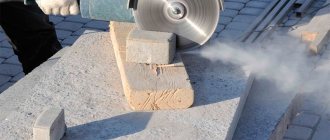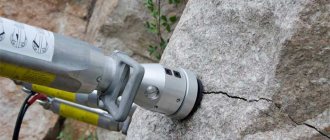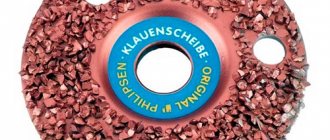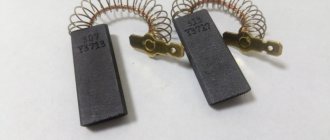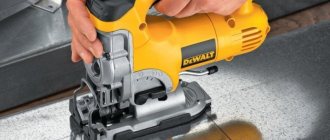There are diamond blades for cutting concrete products or bricks. Also, their variety is used when cutting tiles. Diamond blades are suitable for use with turbines, wall chasers, and also on machine tools.
At the moment, manufacturers provide the market with a very wide range of disks for different devices and different countries of origin.
Characteristics
Diamond blades are very durable compared, for example, to metal blades, and they also save quite a lot of time during the work itself.
Throughout the entire period of operation, the disc will retain both the depth of its cut and practically does not grind down. It is a metal circle made of the strongest steel (for tools), where cutters (diamond dust) are soldered at the end of the circle.
The welding used there is not conventional, but laser. Diamond spraying is done using a press, where the dust itself is pressed against the metal part of the product.
Working with diamond blades
As noted earlier, diamond blades are used for both dry cutting and wet cutting. Each type has its own nuances that should not be neglected.
Return to contents
Dry method
Dry cutting method with a diamond disc.
The dry method involves purchasing abrasive wheels in which, for faster cooling, air passes between the segments, which appears during the processing of stones of both natural and artificial types. This product construction technology ensures removal of dust from the cutting area, which facilitates work and increases its efficiency, and also removes dust on reinforced concrete. Most often, an abrasive wheel with a diameter of 230 is used, and the cutting depth is no less than 22 mm. This is enough to lay the wiring. To create channels for pipes, you should purchase a product with a diameter of 350.
The dry treatment method is used when repair and construction work is carried out in a room with already installed communications, when the use of water can lead to irreversible consequences. To begin work, the surfaces are cleaned of dirt. Anyone working must remember to take breaks to cool the cutting wheel. Otherwise, the tool will fail. The depth of the passage over reinforced concrete should not exceed 25 mm. To get a deeper cut, you need to insert the tool several times. Also, if work is carried out on reinforced concrete, it is necessary to make shallow cuts without getting into the metal frame. Therefore, it is advisable to use circles with a diameter of 230 mm or more.
Return to contents
Wet cutting
This method involves the use of solid (solid) circles in which diamond coating is applied to the outer diameter. They can be divided into regular and turbo, on which an additional layer of diamond dust is applied. The turbo has a wave-like surface, which increases the level of cooling. Diamond blades for reinforced concrete turbo are considered more durable and are used for cutting reinforced concrete. In general, the wet method is convenient in that the water cleans the area where the work is being done and cools the circle, which makes the work easier. The turbo circle is not sensitive to reinforcement.
A diamond disc for concrete is used to work with strong materials, while during operation there is a relatively low, almost silent, volume level. During work, this product emits much less dust and can be safely used during renovations in an apartment.
Return to contents
Varieties
Diamond blades are available for dry and wet cutting. Dry cutting discs are distinguished by the presence of special segments, which are not found in grinding discs. Now about the types in more detail.
A dry cutting disc for concrete is also called a cutting disc. There are special channels on the circle, between which there are sectors. This is due to the need to reduce stress on the cutting plane.
These channels also discard slag and other waste that occurs during cutting. From a technological point of view, such discs have a special type of boring that distributes stress and loads much better than usual.
Discs for grinding concrete. They are also called infinite. Its visual difference from its analogues is the absence of cuts on the edges of the disk, and the holes themselves (technological recesses in the shape of a circle) are usually located along the entire radius. They are also necessary for better voltage distribution.
But the main difference is that when using cutting discs of this type, a constant supply of water is required. Many people do not fully understand the structure of such disks, so it is better to look at the photo.
The best diamond blades for stone
It is possible to carefully cut stone without chipping only at high speed. To do this, use solid and segmented circles designed for wet or dry cutting. Natural stone is a difficult material to process, and it is worth taking a responsible approach to choosing equipment for processing it. Our team offers three models created using different technologies. The tool is distinguished by good quality of the working layer, accurate cutting and durability.
Dremel DSM540
Classic solid disc designed for cutting natural stone, clinker, ceramic tiles. Suitable for dry cutting at 20,000 rpm. It has good performance and can accurately cut stone of any hardness. Used with compact specialized saws and branded angle grinders. It has a diameter of 77 mm and a mounting hole for the shaft of 11 mm, which limits the choice of power tools.
Small sizes allow you to perform high-precision operations and make complex cuts in ceramic tiles. The wide cutting edge and even distribution of diamonds guarantee a long service life under intensive use. The circle is distinguished by its high-precision plane geometry and tight fit, earning regular positive feedback from professionals carrying out complex interior projects.
Advantages:
- Increased resource;
- Thin cut without chips;
- Uniform wear of the cutting edge;
- Resistance to critical temperatures.
Flaws:
- Overcharge.
Practice Do it yourself 036-339
Domestic diamond disc for tiles, which is designed for classic angle grinders. Combines a good safety margin with a high cutting speed. Recommended for wet cutting: coolant provides extended service life at 12,250 rpm and reduces interruptions. The circle can be used for processing artificial and natural ornamental stone.
The small thickness of 1.9 mm helps the master make a neat cut without defects, which is especially important when adjusting the dimensions of expensive ceramics. The low price makes the equipment the best choice for domestic use. According to reviews from home craftsmen who carry out interior decoration themselves, purchasing components helped reduce repair costs.
Advantages:
- Tight fit;
- Light weight;
- The working part is not salted;
- Uniform diamond structure in the cutting edge.
Flaws:
- Application skills required.
Di-Star 1A1R Decor Slim
Di-Star offers a solid diamond blade that can quickly cut stone, tile and porcelain stoneware. The equipment is designed for installation on an angle grinder. The super-thin diamond layer of the cutting tool has an increased service life, good wear resistance and allows you to make a neat cut.
Equipment for dry cutting at a speed of 12,000 rpm has been developed. Special holes provide effective heat dissipation, increasing the intensity of operations. Artificial diamonds are evenly distributed across the width of the cutting part, which increases the quality of cutting thick porcelain floor tiles.
Advantages:
- Edge height 8 mm;
- Smooth cut without chips;
- Tight fit on the shaft;
- The lightweight design reduces the load on the grinder.
Flaws:
- High price.
What other diamond blades are there?
For cutting concrete, discs that are made of reinforced materials are used. Their thickness is extremely wide, because then there is much more spraying.
During manufacturing, a layer of diamond sputtering is applied to the surface of the discs, distributed in a ring. This is clearly visible from the side; this edge of the circle is also called a “cup”.
When grinding concrete, structurally complex discs are used. They have a base made of tool steel on which grinding cups are mounted.
Tool selection
When purchasing a circle for an angle grinder, many factors are taken into account that determine the final choice. Each individual case requires an individual approach. The main conditions on which the characteristics and optimal dimensions depend are:
- Material. Most often, ordinary concrete is processed with segment tools for dry cutting. The new concrete surface has a high level of abrasiveness. This causes rapid wear of the discs. For such work, it is better to purchase thicker discs. Old concrete is stronger than young concrete, so it is better to use options of moderate thickness. If the cement-sand mixture includes quartz sand or balsate, then the abrasiveness of the concrete goes off scale. It is better to choose options where diamond plates are soldered with silver to the base. If you need to cut reinforced concrete, granite or concrete, then a soft diamond wheel is used.
- Cutting method. Wet technology allows cutting reinforced concrete and concrete accurately and quickly, avoiding dust and overheating of the tool. But before purchasing solid discs, you need to make sure that the cutting equipment has a cooling system. For dry cutting, buy segmented circles.
- Working conditions. For home use, products with the optimal ratio of quality and price are selected. They will be able to cope with reinforced concrete and medium-reinforced concrete. If you use them periodically and avoid overloading, they will last quite a long time. Professional discs are designed for continuous use. They have increased durability and wear resistance. Distal and Bosch companies produce the best samples. Such products must be purchased strictly for their intended purpose: concrete cannot be cut with a disk on marble.
- Equipment and cutting depth. The deeper you need to make the cut, the larger the diameter of the circle should be. At the same time, you should not forget about the capabilities of the device. If you attach a disk that is too large, its linear speed will be very high, which will lead to rapid wear. And if you put on a small one, the car will heat up and slip. For powerful wall saws, diamond circular saws are produced, the outer diameter of which should not exceed 1200 millimeters. To work with large-sized foundation blocks and concrete elements, machines with a working diameter of 350-400 millimeters are needed.
Circles for hand-held power tools have more modest dimensions. For cutting concrete when renovating a room, products with a diameter of 115-120 millimeters are used. To process lintels in openings, slopes and other elements, grinder discs for reinforced concrete and concrete are used, the diameter of which is 150-230 millimeters.
The wall chaser works in the same way as the grinder. But the concrete is grooved with two diamond wheels. The width and depth of the cut are adjustable during operation. The diameter is selected depending on the depth of the groove. It ranges from 110-365 millimeters. Grooves for any communications can be made using dry technology, efficiently and quickly, using a powerful wall chaser and diamond wheels for reinforced concrete.
Dimensions
Almost all tools have their own standard size, diamond blades are no exception. The standard sizes are indicated in the markings, which indicate the width (of the slots), the diameter of the disk and the diameter of the hole for attaching to the turbine. If the width of the slot is not indicated, this means that it is minimal.
For construction, circles with a larger slot depth, which can reach up to 60 cm, are rarely used. Such discs are used in specialized industries involved in working on stone and marble.
The Best All-Purpose Diamond Blades
You can buy any specialized equipment for the job, but regularly changing the working tool has a negative impact on labor productivity. If you have to work with concrete, ceramic tiles, or metal at a construction site, then it is better to purchase universal discs. Manufacturers produce wheels that accurately cut any building material without negative consequences. The catalogs contain consumables designed to work with tools that have different speeds. The VyborExperta.ru team studied the effectiveness of circles from the best American and European manufacturers. Experts suggest choosing one of 3 models that are equally easy to cut profiles for gypsum boards and porcelain tiles.
Di-Star 1A1RSS/C3-H Technic Advanced
Engineers of the Ukrainian-Italian company have developed a cutting-off segmented diamond blade for universal use. The wheel is designed for dry cutting at 6650 rpm and is suitable for use by personnel with little experience. Consumables are supplied with angle grinders and wall chasers. The design feature is the complex shape of each of the 10 segments. Advanced geometry ensures maximum heat dissipation even when the operator uses power tools with the covers closed.
The complex shape helps to remove not only heat, but also dust. The wheel copes well with reinforced concrete, granite, paving slabs and baked bricks. The diameter ensures high productivity when gating walls made of monolithic concrete. The manufacturer increased the height of the diamond layer to 12 mm. This helped to increase the resource and efficiency of equipment use.
Advantages:
- Work without breaks for up to 5 minutes;
- Manufacturer's warranty 3 years;
- High cutting speed;
- High-quality cutting at a depth of up to 5 mm;
- Tight fit.
Flaws:
- High price.
Bosch Standard for Universal
Engineers from a German company have developed a universal cutting tool that does not require sharpening or regular replacement. The tool steel wheel has 8 large segments located at a slight angle to the axis and a turbocharged edge structure. This allows for heat dissipation and good contact with the material being processed. Consumables are designed to complete grinders and wall chasers operating at a speed of 12,250 rpm.
The thickness of the circle is 2 mm - the optimal balance for working with concrete, metal or ceramics. The layer of cutting crystals has a height of 10 mm, providing high performance and increased service life. Artificial diamonds with sharp edges are evenly spaced in the edge structure. This guarantees high-quality processing of the material after prolonged use.
Advantages:
- High cutting speed of concrete;
- Ideal surface geometry;
- Lack of combat;
- Smooth cut without defects for any building materials;
- Low price.
Flaws:
- Not detected.
Dewalt DT3711
Sintered universal disc made of high-quality tool steel, which provides the components with high wear resistance and strength. The classic segmented edge allows you to work at high speeds - up to 12,000 rpm. Good heat dissipation increases service life and thermal stability. The equipment is designed for dry cutting and is used on angle grinders or wall chasers.
The high strength of steel made it possible to reduce the thickness of the circle to 1.8 mm without losing the main performance characteristics. The tool cuts all building materials carefully, without chipping. The edge does not become greasy due to the uniform distribution of diamonds throughout its thickness.
Advantages:
- Durability;
- Low price;
- Strict geometry;
- Tight fit.
Flaws:
- The edge height is only 7 mm.
Price
The price of a disc depends on two factors: diameter and quantity (quality) of spraying. With a disk diameter of 120 mm, the price for options with the smallest coating will be about 150 rubles, with an average one - 380 - 450 rubles, and for disks with high quality coating you can pay from 600 to 800 rubles.
The larger the diameter, the higher the price, usually from the previous one you can safely multiply by 45%, but the best discs for large diameter concrete cost more than 1000 rubles.
Recommendations for selection
The main criterion is the compatibility of the diamond wheel with the working tool and the selected cutting technology. It is important to understand the principle: the diameter and rotation speed of the disks cannot be greater than that allowed for the existing wall chaser or grinder; products for wet cutting are not used in the absence of supplied water; the opposite situation is permitted. Diameters and methods, taking into account the type of construction tool, are given in the table.
| Type of equipment | Diameter, mm | The optimal method for cutting concrete | |
| Outer | Landing | ||
| Hand cutter | 300-400 | 25,4 | Both ways |
| Cutting machine | 500 | 60 | With continuous water supply |
| Grinder or wall chaser | 115-230 | 22,23 | Dry cutting |
The indicated values are average and recommended; to eliminate errors when choosing diamond blades, the following are consistently taken into account:
1. Density and abrasiveness of concrete. Freshly hardened solutions wear out wheels faster and require the use of thicker cutting tools, especially if they contain coarse-grained quartz sand, granite or basalt. When processing reinforced and high-density materials, it is worth choosing diamond discs for reinforced concrete with silver soldering. The minimum recommended thickness of products is 2 mm.
2. Intensity of operation. For one-time work, products with an affordable price and average wear resistance are purchased, for professional ones - designed for a long service life, with high quality and a percentage of diamond chips.
3. Type of working equipment and the presence of a water cooling system. Disks for hand-held power tools have a segmented or turbocharged design and are used mainly for dry cutting; continuous water supply is provided in professional machines.
4. Required cutting depth, this factor is influenced by the diameter of the circle. A large value (above 350 mm) is required when working with volumetric structures and wall blocks, when processing slopes, openings or window lintels - in the range of 150-230, when carrying out internal repairs (grooving for wiring, laying small channels) - 115-120. The upper limit depends on the parameters of the working tool; the diameter of the diamond wheel for a wall chaser (it should be remembered that there are two of them) varies from 110 to 365 mm, for an angle grinder – 230 mm.
5. Dimensions of the mounting hole. When processing concrete, the recommended minimum is 20 mm.
6. Disc quality, manufacturer reliability. Good professional discs for reinforced concrete are offered by Bosch, Keos, Hilti, Distar; acceptable products include products from Zubr, Metabo, Norton, Matrix and many others. Attention is paid to the thickness and method of sputtering the diamond layer; for durable discs, the crumbs are distributed throughout the entire volume of the cutting part.
7. Maximum permissible disk speed. This figure cannot be less than that of a working tool.
All this data must be indicated on the packaging; the markings on the diamond blade itself include information about the main dimensions and material. Grinding bowls are selected according to their intended purpose (rough processing or polishing).
Cost of nozzles
| Name, manufacturer | Type, purpose | Cutting method | Maximum rotation speed | Thickness, mm | Landing diameter, mm | Disc diameter, mm | Price, rubles |
| Special, China | Segmented diamond cutting disc | dry | 6600 | 2,4 | 22,23 | 230 | 825 |
| Hilti DC-D | 12250 | 2 | 125 | 630 | |||
| Jet Norton Granite, Poland | Solid with a wavy turbine edge, cutting reinforced concrete is allowed | 13300 | 2,2 | 115 | 430 | ||
| Metabo, Germany | Solid diamond disc with welded diamond edge | wet | 12200 | 2,15 | 125 | 425 | |
| Keos Professional, South Korea | Segmented, high tooth frequency | Both ways | — | 3,2 | 25,4 | 230 | 9560 |
| Anchor Expert, Russia | Turbocharged, for cutting reinforced concrete | dry | 12900 | 2,2 | 22,23 | 125 | 710 |
| Iterskolar Era, China | With a turbo edge with a diamond concentration of more than 30% | 6600 | 2,5 | 230 | 1140 | ||
| Bosch Best for Concrete, Germany | Diamond wheel for grinding thick layers of concrete | — | — | 4,5 | 125 | 11200 |
Feedback on area of use
When choosing and purchasing diamond blades, you need to decide on the type of work that will be performed, as well as the operating conditions. When buying cheap disks, you should take several pieces, as their quality will be very mediocre.
When working in ordinary rooms with not particularly thick walls, the usual version of 12-13 cm is suitable, but when cutting concrete lintels it is better to take discs from 20 to 25 cm.
How to choose diamond blades
Wheels with a cutting edge made of artificial diamonds are used for high intensity construction work. The tool allows you to make hundreds of cuts when used correctly. When choosing consumables, you need to take into account not only brand awareness and price, but also technical characteristics. This will help you purchase products that meet your goals. Understanding the features of a diamond wheel, you need to evaluate its diameter and design features. The cutting tool must be designed to work with a specific building material. The specifics of dry or wet cutting are also taken into account.
Diameter
The outer diameter must correspond to the design features of the tool used. Particular attention is paid to models equipped with a casing: equipment with a large diameter simply cannot be installed if the protection interferes with it. Before purchasing, you should check the diameter recommended by the power tool manufacturer. If you have a choice, then it’s worth remembering: the larger the radius, the deeper you can cut the building material.
The inner diameter of the circle is of particular importance. The parameter must correspond to the characteristics recommended by the manufacturer of the angle grinder or wall chaser. Deviations are not acceptable, since the equipment will dangle on the shaft, which can result in serious injury, tool breakage, and damage to the material being processed. The most widely used models are those with mounting holes of 22.2 and 25.4 mm. The manufacturer indicates all dimensions on the components in the labeling, duplicating the information on the packaging.
Processing material
Building materials differ in different densities, hardness, and structures. High-quality cutting requires different speeds and specific dynamics of heat removal from the working area. Depending on the structure of the material being processed, crystals with different grain sizes are used. Designers select the optimal edge configuration and distribute diamonds evenly throughout the entire depth.
The buyer does not need to be a materials science specialist to select components for his tool. You need to know what material you will be working with and purchase the appropriate equipment. Manufacturers produce wheels for working on metal, concrete, ceramic tiles, porcelain stoneware, and stone. Standing apart from this list are universal discs that effectively cut several materials at once. Using such equipment allows you to save time when replacing it. When choosing a universal circle, you need to clarify what materials it is intended for. Information can be obtained by examining the surface - the manufacturer applies special markings or inscriptions.
Type of diamond blade
Manufacturers produce circles that differ markedly in their design. Solid discs are made from a solid metal plate with cutting crystals applied to the outer edge. This type of wheel is used when cutting at low speeds. To remove heat, slots are made in the steel plate, which can have a simple or complex shape. The slots have a size of 10-15% of the total diameter and are directed towards the center; they divide the disk into 8-10 segments. This type of equipment is called segmented; the tool is designed to work at high speeds.
You can find circles with frequently notched edges. This tool is classified as a turbo. The equipment is highly durable and can operate under constant loads. Combined discs with a segmented surface and notches are called turbo-segmented circles. The main advantages of this product are good performance and versatility in relation to the materials being processed.
Wet or dry cutting
Heat dissipation is the most important problem that has to be solved when cutting building and structural materials. There are three main approaches: reducing the cutting speed, increasing the area due to segmentation, and supplying a cutting fluid to the working area. The last solution is called wet cutting. The technique requires the use of a special tool, which has a complex design and high price, and requires work skills. It is paired with consumables that are designed for wet cutting.
Dry cutting wheels are the most widely used. This is facilitated by the emergence of structural materials with high heat resistance and wear resistance. The equipment operates at high speed and is only slightly inferior in productivity to wet cutting tools. The only drawback is that it is required to periodically stop work, which is unacceptable when solving critical problems.
The best tile cutters



